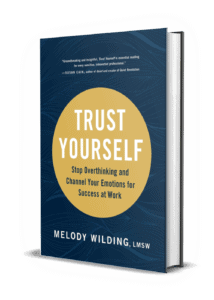Embracing ambiguity in the workplace, while necessary, can be a challenge. After all, it’s natural to desire direction and a sense of control in our careers. It’s comforting to have specific instructions provided to you or to have a clear vision of the future to work towards.
However, uncertainty at work is a part of life in today’s business world, especially after the COVID-19 crisis. If you don’t become skilled at tolerating ambiguity, you can quickly become overly timid and risk-averse.
This is particularly true for Sensitive Strivers. As deep feelers and thinkers, we can all too readily spiral into fear of the unknown and fear of failure. As perfectionists, many Sensitive Strivers tend to be uncomfortable with uncertainty because there’s no clear-cut “right” or “wrong,” which breeds stress, self-doubt, and overwhelm.
After over a decade of coaching sensitive, high-achieving leaders and professionals, I can tell you first hand that a fixation on structure and a constant need for affirmation can limit your potential and prevent you from taking leaps that could elevate your success, such as pitching an innovative idea for a new project, stepping up into a larger role, or even starting your own business.
Ambiguity Tolerance: What it is and Why it Matters
Ambiguity tolerance is a fancy term for “operating in the gray.” It reflects an ability to accept unclear, uncertain, or novel situations and work effectively in this environment.
Tolerance of uncertainty at work can include:
- Willingly taking on new tasks without much prior experience
- Acting even when you’re unsure of the outcome
- Making a judgment call with partial data
- Feeling comfortable with new co-workers, teams, or collaborators
- Seeing situations as spectrums, not dichotomies (good/bad, right/wrong, etc.)
- Navigating conflicting viewpoints
- Working well under changing conditions
- Embracing complexity
- Staying calm if routine or habits are thrown off
- Gaining the information needed to solve problems
- Speaking up and offering ideas even when you don’t have all the answers
- Displaying a desire for work that pushes you
Honing your ability to thrive within ambiguous circumstances is vital. By improving your tolerance for uncertainty at work, you can adapt to ever-changing situations, gain confidence in your decision-making ability, and become more impervious to criticism. In fact, studies show that professionals with ambiguity tolerance tend to have higher job satisfaction, better mental health, and greater emotional intelligence.
Ways to Improve Your Tolerance of Ambiguity at Work
1. CHANGE THE WAY YOU SEE UNCERTAINTY
How you perceive a situation dictates your response to it. And up until now, you probably viewed ambiguous situations as dangerous or threatening. That perspective doesn’t serve you and only reinforces the belief that tolerating ambiguity is something you’re bad at or otherwise want to avoid.
Instead, flip your mindset. Start changing your narrative to redefine ambiguity. You don’t have to see uncertainty as something desirable. Still, you can begin accepting it as a chance to use your natural aptitudes as a Sensitive Striver, particularly your ability to think deeply, handle complex topics, and problem solve. Your knack for spotting nuances and making connections others miss means you’re skilled at bringing innovative ideas to the fore. Focus on the strengths you offer when times are confusing – not what you lack.
Adjust your self-talk to reflect the reality you’re facing with phrases like, “It’s only human to worry” and, “This is scary, and I’m not alone in feeling that.”
2. TAKE CONTROL
Remaining passive in the face of uncertainty at workplaces is a position of powerlessness to your boss and peers. You end up feeling as if situations are happening to you. That’s why assertiveness is a core aspect of embracing ambiguity. It helps you regain a sense of inner mastery, competence, and self-efficacy in the face of fast-changing, external circumstances.
Being assertive involves:
- Standing your ground. Projecting confidence, taking up space, and pushing back when you need to requires that you value yourself enough to put forth your ideas, even at the risk that others won’t like them.
- Approaching situations with objectivity and respect for others’ viewpoints. Speaking up for yourself clearly and concisely means that you can work through confusion in a low-stress, no-drama way.
- Finding win-wins where possible. Act with integrity and in alignment with your values, regardless of whether you get your way or not.
3. DON’T REACT – RESPOND
As a Sensitive Striver, you are more in touch with your emotions. Use this to your advantage to convey calm curiosity when ambiguity arises. While others may be frantic, your emotional equilibrium serves as a superpower.
To stay in that positive headspace, make sure you’re taking steps to keep negative self-talk at bay (you know, the voice that says you’re not good enough, smart enough, and have no idea what you’re doing). Use your valuable energy to focus on the future instead of dwelling on mistakes or missed opportunities. Adopt the mindset that difficult situations are temporary and solvable, not permanent and pervasive.
It’s nearly impossible to shift from worry to possibility when you’re drained and burned out, so invest in your own self-care so you can continue to refocus your mind on hopefulness and optimism.
4. Make Small Bets
One way to manage the unknown’s daunting scale is to break down risks into a series of experiments or small bets. Basically, you want to test the water before you jump in.
For example, if you are considering a new business strategy, a small bet might be approaching senior leadership about launching a pilot first.
Another way to understand this concept is through iteration, which is just a fancy way of saying you’re adapting, building, or expanding upon an idea. The goal is to test theories quickly and rigorously, evaluate the outcomes, and then evolve, pivot, or scrap it. Not every idea is inspired and deserves a comprehensive pursuit.
If you are in charge of product design for your company, iteration helps you sort through the good ideas, weed out the bad ones, and foster the spectacular ones. The same is true for marketing techniques; sometimes, the campaign you develop is a complete flop, but the important thing is that you learn from the experience and incorporate your newly acquired knowledge into future projects.
By trying out ideas on a smaller scale, you provide yourself the chance to evaluate how risky an idea is while simultaneously minimizing any potential negative impact if it doesn’t work.
Clarity comes through action. Making a decision is ultimately better and more efficient than spending days, weeks, or months spinning in doubt.
5. Avoid Over-reliance on Plans
Ambiguous circumstances can be particularly scary for Sensitive Strivers because we do best with structure. And it’s true that organization can lead to efficiency, but it’s also possible to over-optimize and become too dependent on the plans you’ve made and the system you abide by.
When you make long-term career plans, you should be flexible enough to review, adapt, and change them as necessary. If you’re too rigid, you’re probably going to have a problem dealing with randomness you have no control over. Things change, and the goals you’ve set yourself may not be achieved on the timeline you had hoped or in the way you imagined.
For example, maybe you accept a job with the promise of leading a new division that’s set to launch in six months. But after one year, there’s still no progress. If you’re too rigidly fixated on your five-year plan, you may continue to wait (and wait) for a promotion that ultimately never materializes, sacrificing years of your career and earning potential in the process. Instead, be willing to roll with the punches and adapt, perhaps agreeing to move to a different department in the company that offers more upward advancement or makes the leap to a new company that will allow you to achieve your professional goals.
If you rely on and focus on one firm plan, you’ll undoubtedly miss opportunities that arise along the way just because they don’t fit your career scheme. You may be working in a client-relations department when an associate at another company recognizes your talents for event planning and offers you a related role. Although it may not align with what you envisioned for your next job, if the position offers an opportunity for growth along with a great salary and a positive work environment, it’d be shortsighted not to at least consider it.
6. Embrace the Inevitable
One of the scariest things about accepting ambiguity in the workplace is the inability to plan for the unexpected. And yet in life, things rarely go exactly as we think they will. It’s impossible to anticipate when someone’s going to call in sick or when your supervisor will spring a surprise on you. You can really only plan for the fact that unpredictable things are going to happen.
When unpredictable things aren’t good, they, nonetheless, don’t need to be crippling. By practicing negative visualization, a psychological tool intended to help you avoid emotional instability during stressful situations, you can learn to manage your emotions effectively when things go south. Imagining worst-case scenarios before they happen will enable you to anticipate and navigate setbacks.
If you fear getting fired, consider how you might react if this were to happen. What would you say? What would you do next? You’d likely formulate a plan that involves polishing your resume and using your network to secure interviews—a far cry from ending up broke and homeless, a dramatic worst-case scenario.
The process works because it’ll empower you to assess circumstances rationally rather than reactively, thereby avoiding career-damaging hasty decisions. You’ll often find that the “worst” you prepared for doesn’t come close to representing the reality of the situation.
Whether your supervisor has started asking you to manage your quarterly projects completely or you’re keen on laying the groundwork for a brand new initiative, building a tolerance for uncertainty is a necessary job skill. The ability to work through assignments without supervision or explicit direction is an indispensable professional strength, and you can’t survive a changing workplace without it.









